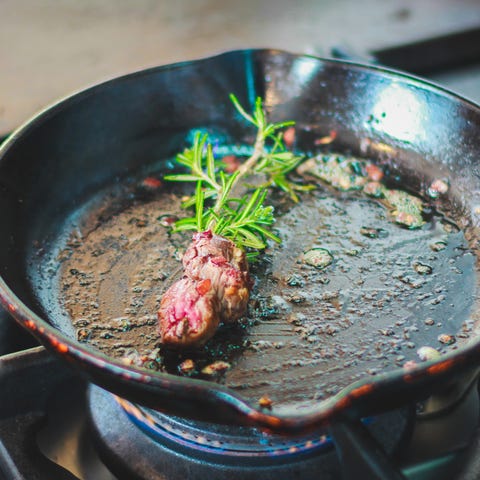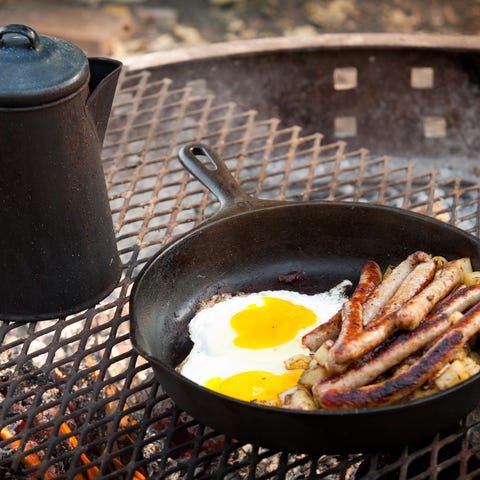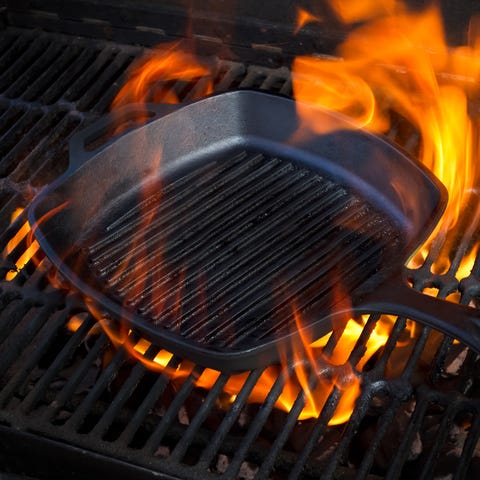how to clean cast iron pan rust
A cast-iron pan is the reliable workhorse of the kitchen, but, like a real horse, it can get absolutely filthy—and people seem equally skittish about cleaning either.
One of the main virtues of iron-carbon alloy (that's the scientific term for cast-iron) is its extreme durability. In fact, some fans of cast-iron often talk about one pan lasting generations.
Yet somehow there's an idea that regular old soap and water is kryptonite to cast iron because you'll wash away the "seasoning." This, coupled with myths about using fire to deep-clean cast-iron, as well as a whole host of other falsities, can make the idea of using cast-iron for cooking as an intimidating endeavor.
And, to top it all off, there's the supposed threat that not cleaning your cast-iron cookware properly can cause you to incur some kind of gnarly food-borne illness.
Fear not.

Men's Health
"There is a lot of misinformation out there about cleaning cast iron," says Gregory Stahl, who is both co-founder of a Massachusetts-based society dedicated to collectors of cast iron and a graduate of Harvard Medical School.
Speaking from Stahl's experience as a medical graduate, he says not cleaning a cast-iron pan probably won't make you sick. That's because cooking generally requires temperatures too high for illness-inducing bacteria to survive.
So if you're heating your food to the USDA's safe minimum internal temperatures, your cast-iron pots and pans will also reach those temperatures (and likely well past).
But as a collector who personally owns a few thousand pieces (some worth thousands of dollars), Stahl strongly advises regular cleaning. ""f you don't, you will eventually get a crusty buildup in the bottom of your pan from burned-on food debris," he says.
And when that happens—when your pan gets a telltale "textured" bottom—your only recourse is to strip it down to the bare metal and start the seasoning process all over again. (If that sounds like a lot of work, yes, it is.) This is also what Stahl recommends if you come across a secondhand pan that you want to restore, but more on that later.
So what is this "seasoning" anyway?
"Seasoning" is what protects cast iron from rust and makes for a smooth, nonstick cooking surface. It doesn't take years to build up, just a few rounds in a hot oven between thin applications of oil or lard. Most new cast-iron pans come pre-seasoned (and there's always cast-iron enamel pans if you don't want to deal with all this seasoning business).
Because this is essentially what cooking does—oil, heat, repeat—the more you use a pan, the better cast-iron cookware grow with each use. But that leads some people to think they should never wash their cast iron skillets, which isn't the case.
This content is imported from {embed-name}. You may be able to find the same content in another format, or you may be able to find more information, at their web site.
So, do you clean a cast-iron skillet after every use?
It depends on what you mean by "clean."

kolderal
Sometimes, after say, grilled cheese, all you may need is a quick swipe with a dry paper towel and re-seal with a dab of oil and a swirl of the same paper towel.
Or you cooked bacon in the pan 10 minutes ago and now the grease has cooled. Take a paper towel or three and wipe out the grease.

Cast Iron Dual Handle Pan, 12 inch
Lodge
Yup, that's it.
But let's say you've make a saucy mess. The best fix, says Stahl, is to fill your skillet with water and bring it to a boil on the stovetop.
Then let it cool enough to scrub with a nylon sponge. Then reseal.
So, do you re-seal a cast-iron skillet after every cleaning?
It's a safe bet.

debibishop
And before you reseal the pan make sure that you're drying the pan thoroughly. If there are any water spots on the pan—on the surface, handle, or the exterior—you may risk something called "flash rust," the light orange particles that can appear. While you can easily scrub them off, it's easier to prevent them in the first place.
To reseal, almost any oil will work, as will shortening or lard, as long as your pan is in regular use.
If you don't plan on using it for a while, those greases and oils with lower smoke points can go rancid. (There are products made to combat this, like Crisbee, which is made from beeswax, but Stahl says Crisco works just as well).
Can you use Brillo pads? Steel wool?
Eh, not a great idea.

While cast iron is tough, you can still scratch and mar the surface if you're too aggressive with your cleaning. Scars in the surface of the pan—shallow or deep—increase the risk of rust.
This is the same reason that you should try to avoid metal utensils when cooking with cast-iron. It's not that if a metal fish spatula graces the surface of your pan that its surface will be immediately and irreparably marred. But you do run the risk of scarring the pan if you're too rough or an accident causes a scratch. So stick with wood and rubber cooking utensils when cooking with cast-iron.
If the pan is nasty, and you've already tried the old boil-and-wipe method, pour some kosher salt into the pan and scrub it with a paper towel. Rinse and repeat, if needed.
If my pan is clean, why is food still sticking to it? And what is that black residue?
That black residue is carbonized food and your food is still sticking to the pan because of it.
During or after you boil the water in the pan, take the edge of a wooden spoon and scrape it against the bits. The water should soften the gnarly bits and the spoon will be able to remove them more easily that way.
What about fire- and sand-blasting cast-iron pans?
Stahl never recommends either.

grandriver
There is an idea that if you stick a pan directly in fire, it will burn away all the debris. But fire is way hotter than an oven, and can actually discolor the metal, says Stahl. And where seasoning is a chemical bonding process, sandblasting strips away the actual surface of the metal, not just what's stuck to it. After that, it can be difficult to season, he says.
What should I do if there's rust on a cast-iron pan?
Stahl's recommended method: Spray the pan inside and out with oven cleaner and tie it inside a plastic bag to keep it from drying out. After a few days, take it out and scrub it with soap and water, then repeat until the dark patina on the pan is completely gone.
This content is created and maintained by a third party, and imported onto this page to help users provide their email addresses. You may be able to find more information about this and similar content at piano.io
how to clean cast iron pan rust
Source: https://www.menshealth.com/nutrition/a29608432/how-to-clean-a-cast-iron-skillet/
Posted by: terrellhorer1946.blogspot.com

0 Response to "how to clean cast iron pan rust"
Post a Comment